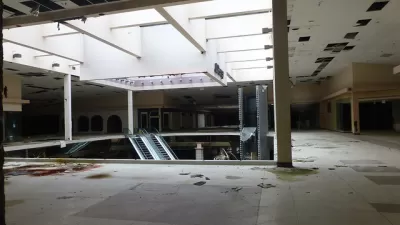A competition to design the shopping mall of the future produces some surprisingly non-futuristic results, according to juror and commentator Allison Arieff.
"Ah, if only the designers and developers of shopping malls paid as much attention to the foot traffic outside the mall as they do to the orchestrated promenade within it."
"At the 2009 International Council on Shopping Centers convention held in Las Vegas last month, pedestrian-oriented development was not top of mind (though in a 3.2 million-square-foot convention center, walking was a defining part of the experience). Despite a nearly 50 percent drop in attendance from prior years, most talk at ICSC was of how business as usual could resume once 'things came back.'"
"I was brought to ICSC as a juror for the organization's inaugural Future Image Architecture Competition, which asked entrants to imagine the shopping mall of the future. My expectations for the entries were high - and probably too preconceived. This seems like a watershed moment for malls, much as it does for housing. Surely, I thought, the entries will reflect the extent to which business as usual - i.e., massive anchor retail tenants surrounded by thousands (even millions) of square feet of specialized yet mass retail, in settings only accessible by car - cannot possibly continue. Having just witnessed the Sony-backed Metreon mall in San Francisco shift from its failed existence as a "state of the art technology and entertainment marketplace" to a modest farmer's market, I'd seen the writing on the wall. Hadn't the shopping center folks?"
"Some have, but surprisingly, many haven't."
FULL STORY: Rethinking the Mall

Maui's Vacation Rental Debate Turns Ugly
Verbal attacks, misinformation campaigns and fistfights plague a high-stakes debate to convert thousands of vacation rentals into long-term housing.

Planetizen Federal Action Tracker
A weekly monitor of how Trump’s orders and actions are impacting planners and planning in America.

San Francisco Suspends Traffic Calming Amidst Record Deaths
Citing “a challenging fiscal landscape,” the city will cease the program on the heels of 42 traffic deaths, including 24 pedestrians.

Defunct Pittsburgh Power Plant to Become Residential Tower
A decommissioned steam heat plant will be redeveloped into almost 100 affordable housing units.

Trump Prompts Restructuring of Transportation Research Board in “Unprecedented Overreach”
The TRB has eliminated more than half of its committees including those focused on climate, equity, and cities.

Amtrak Rolls Out New Orleans to Alabama “Mardi Gras” Train
The new service will operate morning and evening departures between Mobile and New Orleans.
Urban Design for Planners 1: Software Tools
This six-course series explores essential urban design concepts using open source software and equips planners with the tools they need to participate fully in the urban design process.
Planning for Universal Design
Learn the tools for implementing Universal Design in planning regulations.
Heyer Gruel & Associates PA
JM Goldson LLC
Custer County Colorado
City of Camden Redevelopment Agency
City of Astoria
Transportation Research & Education Center (TREC) at Portland State University
Jefferson Parish Government
Camden Redevelopment Agency
City of Claremont





























